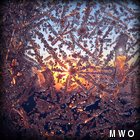The Other Side of Rime
2012-01-20 19:45:44.000 – Ryan Knapp, Weather Observer/Meteorologist
Todays sunset shot through window rime.
If you frequent our Observer Comments, you are probably well versed on what rime ice is. But for those who may have just started reading our blog entries or need a refresher, let me bring you up to speed. Rime ice is a white ice that forms on any exposed surface when there is freezing fog. If you live some place where it is cold, it is likely you have seen this happen on trees, cars, grass blades, etc during foggy times during the winter. More commonly though, it is found on mountain tops where low hanging clouds are touching the surface creating summit ‘fog’. In valley locations where this may form, the coverage is usually uniform coating everything in an eerie, ghostly white. On summits though, rime ice forms heavier on windward facing objects creating large features that point into the wind while the lee of an object remains relatively ice free.
So, how does it form? In a cloud (or fog), billions of minute, super-cooled droplets are being suspended. Now, these droplets we are talking about are small – about a million or more would make up an average rain drop. So, in other words, small and not typically visible to the naked eye. And surprisingly these small droplets are still in liquid form but in a state called ‘super-cooled’. If you remember from grade school, water typically freezes at 32 degrees F or zero degrees C. But in order for water to freeze, it needs what is called condensation nuclei (dust, ash, algae, etc.). This gives the water something to form onto and acts as a catalyst to start the freezing process. Without it though, purified water (in lab studies) in sterile objects has been seen in liquid form down to temperatures of 40 degrees below zero F before something as simple as a jolt or tap on the side of a beaker sets things off in a chain reaction (look for some cool videos of this on YouTube – this also makes a great lab experiment teachers out there). So these liquid droplets in conditions below freezing are called ‘super-cooled’ by meteorologists.
So, as these millions or billions of super-cooled droplets slam into the side of an object, they instantly have something to freeze onto and in a split second, they form a microscopic piece of ice. If it were just one droplet doing this, we probably wouldn’t see anything but in any given second, several millions (if not billions) of these droplets can slam into a given surface. So, for instance, the minute or two we are out deicing, by the time we get in, the side of us facing the wind will be covered in a thin coating of rime ice; sometime even coating something as fine as our eyelashes. While we just come in looking like a glazed donut, over time, rime ice forms sheets, feathers, spikes, mounds and other intricate shapes on objects depending on how wind is slamming onto various structures including other specs of rime. It is because of this rime ice that we have to go out and deice every hour when in the fog. While it can make our jobs difficult at times depending on the type of rime forming (soft, hard, or clear), rime can also provide us with some true beauty up here. So, here are a few pictures (of many taken) of some rime ice from this afternoon.
Sunset shot through rime ice on window
Island of rime ice on northern window
Ryan Knapp, Weather Observer/Meteorologist
Team Flags Return for Seek the Peak’s 25th Anniversary
Team Flags Return for Seek the Peak's 25th Anniversary By MWOBS Staff Mount Washington Observatory is looking forward to continuing a much-loved tradition for Seek the Peak’s 25th Anniversary: Team flags. In inviting teams
Meet Summer Interns Zakiya, Max and Maddie
Meet Summer Interns Zakiya, Max and Maddie By MWOBS Staff We are excited to welcome six teammates to the summit of Mount Washington this summer! During their internship, these students and graduates will play
Saying Goodbye to the Summit
Saying Goodbye to the Summit By Alexis George After an extraordinary last three years working as a Weather Observer and Meteorologist, I am excited to pursue a different career. As sad I as am






